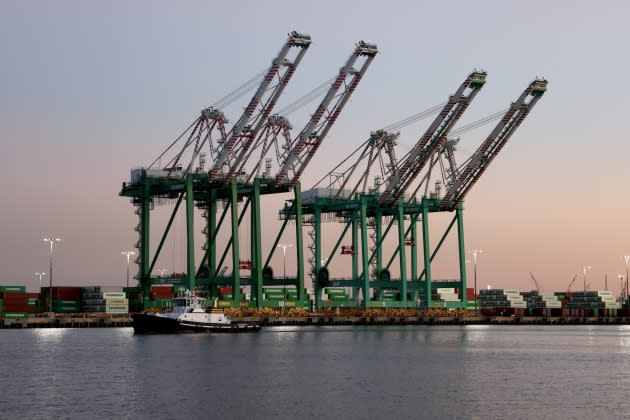When it Comes to West Coast Ports, No One Wants 2015 All Over Again

The disruptions at the West Coast ports as dockworkers and terminal operators try to iron out a new contract caused a brief slowdown as more vessels piled up at sea, but it appears for now that the backups were short lived.
A report from Bloomberg on Thursday said that eight container ships were backed up waiting to dock at the Ports of Los Angeles and Long Beach, with as many as 31 scheduled to arrive within the next week that would be delayed “by about a day or two,” according to The Marine Exchange of Southern California, which oversees vessel movement at the ports of Los Angeles, Long Beach, San Diego and Hueneme.
More from Sourcing Journal
The port congestion had cleared up as of Friday morning, Marine Exchange executive director Kip Louttit told Sourcing Journal.
According to Louttit, there are three vessels scheduled to dock Friday between noon and 2 p.m. PT. as planned, with no ships waiting at anchor as of 9:42 a.m.
From June 1-4, labor shortages roiled major ports across Los Angeles, Long Beach, Oakland and Seattle, with marine terminals closures leading to congestion in the days after. The shutdowns occurred as dockworkers are deadlocked in a contract dispute with their employers over wages, benefits and port automation.
The International Longshoremen and Warehouse Union (ILWU), representing 22,000 dockworkers, and the Pacific Maritime Association (PMA), which represents ocean carriers and terminal operators, have been negotiating a new deal since last May. The previous labor agreement expired on July 1, 2022.
The Pacific Maritime Association (PMA) did not return Sourcing Journal’s request for comment on the vessel backlog.
With retail’s peak shipping season beginning in July, many are keeping a close eye on the potential for new disruption, said Jon Gold, vice president of supply chain and customs policy at the National Retail Federation (NRF).
“Prior to last Friday, I think there was optimism among everybody that the parties were going to be able to reach a deal,” said Gold. “We’ve heard coming out of the disruptions in April that progress was made on some key areas, and there was a sense that they’re in the final stretch. There was a lot of thinking that a final deal could be reached in June. But with what happened last week with the walk from the table and the ongoing disruptions, I think there’s a question now as to kind of where things actually are and when a deal will be achieved.”
The NRF has called on the Biden administration to intervene, with Gold noting that the White House could encourage the PMA and ILWU to use mediation services, which concluded the 2015 West Coast labor negotiations. If a strike occurs, President Biden could also invoke the Taft-Hartley Act, which would mandate arbitration to settle the labor dispute.
The larger the port backlog the longer it will take to clear and get back to normal, according to Judah Levine, head of research at Freightos. In a media update issued Tuesday, Levine also evoked the 2015 negotiations, when two weeks of West Coast terminal shutdowns in January rippled into a backlog peak of 30 ships at berth in March.
“Once disruptions eased it took a month and half for that number to drop to zero but reportedly took another six months until operations had completely returned to normal,” said Levine. “The last time there were 30 ships waiting in San Pedro Bay was in April of 2022. That number was down from the pandemic-driven record of more than 100 at the start of the year, and—working down many previous months’ worth of backlog—it took four more months to get to zero.”
The potential for more congestion could still spook more importers into shifting their goods to the East and Gulf Coasts.
Supply chain visibility platform FourKites said in April that 64 percent of import shipments arriving in the U.S. entered the country via East Coast ports, compared to just 36 percent going through the West Coast. The numbers were a drastic shift from September 2021, when 54 percent of shipments came into the East Coast and 46 percent entered via the West Coast.
“With all the supply chain challenges and strife that we’ve seen throughout the pandemic, this is one that they have some control over and can avoid by making those cargo shifts,” said Gold. “And until there is stability and a contract in place, folks aren’t going to look to shift back to the West Coast.”
